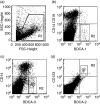BDCA-1+, BDCA-2+ and BDCA-3+ dendritic cells in early human pregnancy decidua
- PMID: 18234052
- PMCID: PMC2276959
- DOI: 10.1111/j.1365-2249.2007.03576.x
BDCA-1+, BDCA-2+ and BDCA-3+ dendritic cells in early human pregnancy decidua
Abstract
Dendritic cells (DCs) can acquire unique features or phenotypes in different tissue microenvironments and decide whether immunity or tolerance develops. DCs observed within the decidua have been implicated in pregnancy maintenance. However, the precise distribution of decidual DC subsets and their phenotypic characteristics are largely unknown. Using flow cytometry, we identified three DC subsets in normal human first-trimester decidua: BDCA-1+ CD19- CD14(-) myeloid DC type 1 (MDC1), BDCA-3+ CD14- myeloid DC type 2 (MDC2) and BDCA-2+ CD123+ plasmacytoid DC (PDC). The percentage of MDC1 to mononuclear cells in the decidua was similar to that in the peripheral blood controls. The percentage of MDC2 in the decidua was significantly higher than that in the peripheral blood controls, whereas the percentage of PDC was significantly lower. Both MDC1 and MDC2 subsets expressed human leucocyte antigen D-related, CD86 and CD80 at low levels, suggesting a characteristic of immature myeloid DCs. Immunoglobulin-like transcript 3, suggested to be involved in immune tolerance induction, was also expressed on decidual MDC1 and MDC2 subsets. In addition, as gestational age increased from 6 to 9 weeks, the numbers of MDC1 decreased but MDC2 increased significantly. This is the first study to demonstrate the presence of three previously unidentified BDCA-1+, BDCA-3+ and BDCA-2+ DC subsets in human decidua, these decidual DCs might play important role in the maintenance of pregnancy.
Figures




Similar articles
-
Quantification of dendritic cell subsets in human renal tissue under normal and pathological conditions.Kidney Int. 2007 May;71(10):1001-8. doi: 10.1038/sj.ki.5002187. Epub 2007 Mar 14. Kidney Int. 2007. PMID: 17361115
-
Predominance of Th2-promoting dendritic cells in early human pregnancy decidua.J Leukoc Biol. 2003 Oct;74(4):514-22. doi: 10.1189/jlb.1102566. Epub 2003 Jul 15. J Leukoc Biol. 2003. PMID: 12960246
-
Expansion of CD4(+) HLA-G(+) T Cell in human pregnancy is impaired in pre-eclampsia.Am J Reprod Immunol. 2014 Mar;71(3):217-28. doi: 10.1111/aji.12195. Epub 2014 Jan 3. Am J Reprod Immunol. 2014. PMID: 24383466
-
Dendritic cells: key to fetal tolerance?Biol Reprod. 2007 Oct;77(4):590-8. doi: 10.1095/biolreprod.107.060632. Epub 2007 Jun 27. Biol Reprod. 2007. PMID: 17596562 Review.
-
Plasmacytoid dendritic cells: from specific surface markers to specific cellular functions.Hum Immunol. 2002 Dec;63(12):1133-48. doi: 10.1016/s0198-8859(02)00752-8. Hum Immunol. 2002. PMID: 12480257 Review.
Cited by
-
An immunohistochemical study of CD83- and CD1a-positive dendritic cells in the decidua of women with recurrent spontaneous abortion.Eur J Med Res. 2015 Jan 7;20(1):2. doi: 10.1186/s40001-014-0076-2. Eur J Med Res. 2015. PMID: 25563385 Free PMC article.
-
Pathological consequence of misguided dendritic cell differentiation in histiocytic diseases.Adv Immunol. 2013;120:127-61. doi: 10.1016/B978-0-12-417028-5.00005-3. Adv Immunol. 2013. PMID: 24070383 Free PMC article. Review.
-
Dynamic Changes in the Phenotype of Dendritic Cells in the Uterus and Uterine Draining Lymph Nodes After Coitus.Front Immunol. 2020 Sep 11;11:557720. doi: 10.3389/fimmu.2020.557720. eCollection 2020. Front Immunol. 2020. PMID: 33013926 Free PMC article.
-
Human Miscarriage Is Associated With Dysregulations in Peripheral Blood-Derived Myeloid Dendritic Cell Subsets.Front Immunol. 2019 Oct 15;10:2440. doi: 10.3389/fimmu.2019.02440. eCollection 2019. Front Immunol. 2019. PMID: 31681319 Free PMC article.
-
Decidual Macrophage Functional Polarization during Abnormal Pregnancy due to Toxoplasma gondii: Role for LILRB4.Front Immunol. 2017 Aug 24;8:1013. doi: 10.3389/fimmu.2017.01013. eCollection 2017. Front Immunol. 2017. PMID: 28883820 Free PMC article.
References
-
- Loke YW, King A, Burrows TD. Decidua in human implantation. Hum Reprod. 1995;10(Suppl. 2):14–21. - PubMed
-
- Billingham RE. Transplantation immunity and the maternal-fetal relation. New Engl J Med. 1964;270:667–72. - PubMed
-
- Mincheva-Nilsson L, Baranov V, Yeung MM, Hammarstrom S, Hammarstrom ML. Immunomorphologic studies of human decidua-associated lymphoid cells in normal early pregnancy. J Immunol. 1994;152:2020–32. - PubMed
-
- Loke YW, King A. Human implantation. Cell biology and immunology. Cambridge: Cambridge University Press; 1995.
-
- Askelund K, Liddell HS, Zanderigo AM, et al. CD83(+) dendritic cells in the decidua of women with recurrent miscarriage and normal pregnancy. Placenta. 2004;25:140–5. - PubMed
Publication types
MeSH terms
Substances
LinkOut - more resources
Full Text Sources
Other Literature Sources
Medical
Research Materials
Miscellaneous

